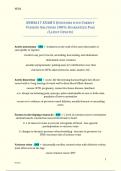NURS
NURS617 EXAM 5 Q UESTIONS WITH CORRECT
VERIFIED SOLUTIONS 100% GUARANTEED PASS
(LATEST UPDATE)
Aortic aneurysms - ANS ✓-weakness in the wall of the aorta that makes it
susceptible to rupture
-involves any part of aorta; ascending, descending, and abdominal
-abdominal=most common
-usually asymptomatic; pulsing mass d/t calcification over time
-risk factors: HTN, atherosclerosis, male, smoker, 50+
Aortic dissection - ANS ✓-acute, life threatening haemorrhaged into blood
vessel wall w/ long tearing of vessel wall to form blood-filled channel
-causes: HTN, pregnancy, connective tissue disease (marfans)
-s/s: abrupt excrutiating pain, syncope, pulse unattainable in one or both arms,
paralysis of lower extremities
-occurs w/o evidence of previous vessel dilation; usually thoracic or ascending
aorta
Factors in developing venous dx - ANS ✓1. level of activity in lower extremities
- skeletal muscle contraction moves blood back to heart
2. # of valves in veins to prevent retrograde of blood - less=genetic
predisposition to varicose veins
3. changes in thoracic pressure when breathing - increase in pressure (ex-
HTN)=increase risk of varicose veins
Varicose veins - ANS ✓-abnormally swollen, twisted veins with defective valves;
most often seen in the legs
-most common cause=DVT
1
NURS617
,NURS
-other causes: increase in abdominal pressure (HTN, obesity), prolonged
standing w/o use of leg muscles to pump blood back to the heart
-tx: compression stockings, calf pumps
Chronic venous insufficiency - ANS ✓-venous circulation is inadequate due to
partial vein blockage or leakage of venous valves (or both); muscle pumps
ineffective
-effective blood flow & emptying of deep veins cannot occur
-s/s: edema, brown pigmented skin on LEs, necrosis, tissue congestion, stiffening
of ankle joint & loss of muscle mass + strength
-secondary lymphatic insufficiency occurs
Venous thrombosis - ANS ✓-formation of blood clot in vein d/t stasis of blood,
increase coagulability, vessel wall injury
-causes: best rest/immobility, pregnancy, birth control, cancer, stress/trauma,
hyperlipidemia, HTN, hip fracture, surgery
-s/s: deep muscle tenderness, pain, hot to touch, fever, swelling
-tests: doppler, d-dimer
-tx: elevate legs 15-20 degrees, compression stockings, prophylactic anticoag (LD
aspirin), heparin or warfarin 3-6mo after tx of thrombi to ensure dissolved
Short vs long term BP regulation - ANS ✓-short=d/t exercise, stress,
hemmorhage; regulated by medulla/reticular formation. SNS=increases HR and
contractility of heart, constricts vessels. PNS=vagal nerve stimulated and
decreases HR, dilates blood vessels
-long=r/t kidney function; decrease in function=increase in BP/HR d/t retention
of h2o + na+
Hypertension in children - ANS ✓-d/t renal disease, coarctation of the aorta,
cystic disease, Wilm's tumor
-causes left ventricle enlargement
2
NURS617
,NURS
Hypertension: risk factors, BP levels, clinical manifestations - ANS ✓-pre-
HTN: 120-139/80-89
-HTN: 140+/90+
-risk factors: men, older age, AA race, lower socioeconomic groups, obesity,
diabetes, stress, alcoholism, high salt (9g+/day)
-HTN=risk factor for atherosclerosis
-manifestations: left ventricular hypertrophy, nephrosclerosis (risk for CKD),
hypertensive retinopathy
Orthostatic (postural) hypotension - ANS ✓-Decrease in both systolic and
diastolic blood pressure upon standing; at least 20mm hg
-take BP supine, after standing for 1 min, and after standing for 3 min
-when changing position, blood pools into lower part of body; causes decrease in
BP, cardiac output, blood to brain
-s/s: dizziness, nausea, syncope, palpitations
-usually worse in AM or with cough/pee/poop
-risk factors: increase in age (decreased baroreflex to adjust HR/BP), diabetes,
altered ANS function (spinal cord injury, CVA), drug induced, bed rest/impaired
mobility
Stroke volume - ANS ✓The amount of blood ejected from the heart in one
contraction
SV= end diastolic volume-end systolic volume; normal=70ml
-<70=impaired heart function
Cardiac ouput - ANS ✓-the volume of blood pumped by one ventricle per
minute, average is 5Lin a normal resting adult
-stroke volume x HR
Ejection fraction - ANS ✓-measurement of the volume percentage of left
ventricular contents ejected with each contraction
3
NURS617
, NURS
-SV/end-diastolic volume X 100
-normal=55-75%
-55%>=heart failure
Arteries vs veins - ANS ✓-arteries: carry blood away from heart; thick, elastic
walls; have highest pressure, provide resistance to circulatory flow
-veins: carry blood to heart; low pressure, thin walls to collect blood from
capillaries (acts as reservoir to return blood to R side of heart); contains largest
amount of blood
Blood flow: normal vs abnormal - ANS ✓blood flow=laminar vessels, one
directional flow
abnormal=turbulent; causes whirlpool or backflow of blood, causes
murmor/bruit upon auscultation
**closed end system
R vs L side of heart - ANS ✓R=pulmonary
L=systemic
-output of both must be the same; if R pumps less, blood accumulates in systemic
circulation...if L pumps less, blood accumulates in lungs
3 factors governing blood flow - ANS ✓pressure, resistance, flow
-increase in viscosity and decrease in temp=decrease in blood flow
Compliance - ANS ✓-total quantity of blood that can be stored in a given portion
of circulation for each mm HG increase in pressure
-compliance=increase in volume/increase in pressure; ability to increase of
decrease depending on BP
-most distended=veins
4
NURS617




